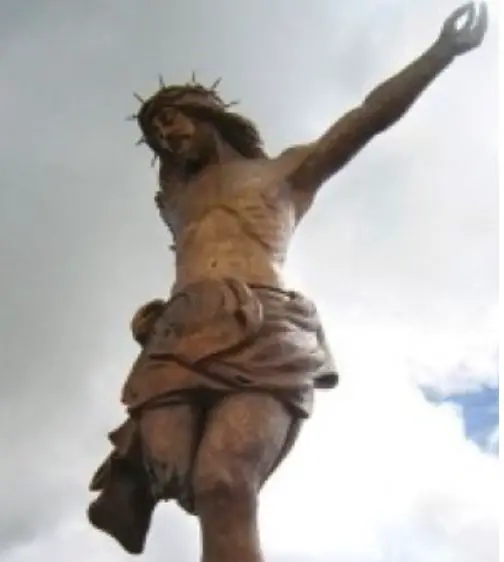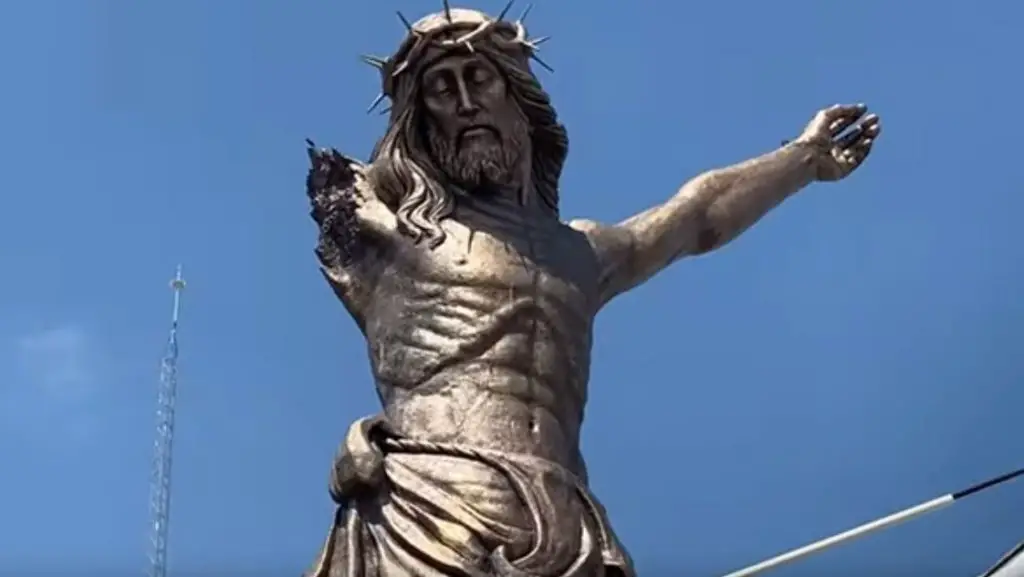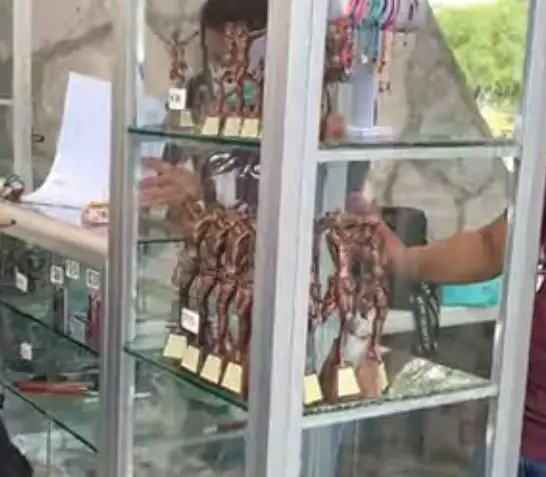Podcast: Play in new window | Download
Subscribe: Apple Podcasts | RSS
 On a bleak island in a manmade lake in the middle of a semi-arid wasteland there stands a gigantic statue of Jesus. His right arm is broken off by the shoulder and his right leg is also missing halfway down the thigh. Although a classic image of the crucified Christ, the sculpture is that of a mutilated corpus only and does not include a cross. Beneath this statue there is a plaque with an inscription on its surface. The inscription starts off with “Déjame roto,” which means, “Leave me broken,” in English. Here is the plaque’s complete translation from Spanish to English:
On a bleak island in a manmade lake in the middle of a semi-arid wasteland there stands a gigantic statue of Jesus. His right arm is broken off by the shoulder and his right leg is also missing halfway down the thigh. Although a classic image of the crucified Christ, the sculpture is that of a mutilated corpus only and does not include a cross. Beneath this statue there is a plaque with an inscription on its surface. The inscription starts off with “Déjame roto,” which means, “Leave me broken,” in English. Here is the plaque’s complete translation from Spanish to English:
“Leave me broken…
I want myself to be seen as broken. Remember so many of your brothers who are like me, broken, crushed, homeless, oppressed, sick, mutilated…
Without arms, because they have no possibilities or means of work; without feet, because they have blocked their paths; without a cross, because they have taken away their respect, honor, and prestige. Everyone will forget them and turn their backs on them even though they are like you…
a broken Christ.”
El Cristo Roto, or “The Broken Christ,” stands 82 feet tall on an island aptly named La Isla del Santuario del Cristo Roto, or “The Island of the Sanctuary of the Broken Christ”. The island is located in an artificial lake behind Plutarco Elias Calles Dam in the northwestern part of the Mexican state of Aguascalientes about 50 minutes from the capital city of the state, also called Aguascalientes. The closest town to the shrine is San José de Gracia on the eastern shore of the manmade lake. For 40 pesos round-trip, which is about two US dollars, the island is just a five- to ten-minute boat ride away. The statue is made of concrete and steel and painted with a finish to make it look like bronze. The sanctuary includes an open-air plaza in front of the gigantic Jesus. Around the perimeter of the plaza are several shrines. Within the glass-enclosed niches are replicas of the Christ statues of all the major churches in the state of Aguascalientes. The plaza plays host to various celebrations and religious observances, especially during the Semana Santa, or Holy Week, preceding Easter Sunday. Although the Christ statue is broken, it was made on purpose to look this way. The whole shrine is relatively new, only being constructed in the year 2006. Since they built the sanctuary, El Cristo Roto has received many thousands of visitors from around Mexico and beyond. A great many of these visitors are simply curious tourists while many come here in search of miracles and divine guidance.
 So, what is the history of the area and how did this sculpture come to be? As mentioned previously, the statue and sanctuary are located on an island in the reservoir behind Plutarco Elias Calles Dam. This dam was the first such project ever undertaken in Mexico. It was built in 1928 and took about 3 years to completely fill up to current levels. Before the dam, the town of San José de Gracia was located in the future lake bottom surrounded by thousands of tall, shade-giving cottonwood trees that the locals used as an endless supply of wood.
So, what is the history of the area and how did this sculpture come to be? As mentioned previously, the statue and sanctuary are located on an island in the reservoir behind Plutarco Elias Calles Dam. This dam was the first such project ever undertaken in Mexico. It was built in 1928 and took about 3 years to completely fill up to current levels. Before the dam, the town of San José de Gracia was located in the future lake bottom surrounded by thousands of tall, shade-giving cottonwood trees that the locals used as an endless supply of wood.
Centuries and thousands of years before the dam, the region was inhabited by roaming indigenous people collectively known as the Chichimeca. For more information about this group, please see Mexico Unexplained, Episode number 142: https://mexicounexplained.com/chichimeca-warriors-of-the-north/ The Aztec Empire and even the Tarascan State tried to either conquer or make peace with the Chichimeca but were repelled. When the Spanish arrived in the Aguascalientes region in the middle of the 1500s, they met with similar resistance from the indigenous. The area was finally subdued about a hundred years later in the 1660s. By the middle of the 1670s all the nomadic Chichimeca were stripped of their way of life and forced to settle in towns or to work on haciendas. Between the years 1673 and 1675 the town of San José de Gracia was formed by families who formerly worked at the Hacienda de Garabato. In the records of colonial New Spain, after its founding San José de Gracia was declared to be an “Indian Town.” The population lost its “nativeness” over the years and slowly adopted the general mestizo national culture found throughout Mexico today. For four days San José de Gracia played host to Father Miguel Hidalgo, the famous leader of Mexican Independence, who was passing through here with a large band of insurgents on what is called by historians, “The Freedom Route.” Hidalgo’s forces engaged with the Spanish army on a bridge in the middle of town called the Puente de Calderón, on January 19, 1811. The rebels suffered a defeat, so they retreated. The bridge had such a drop into the canyon below that it was said that men could not ride horses across it because the horses would be spooked. The bridge, along with the rest of the town would disappear completely under the waters of the Calles reservoir by 1932. Before the waters overtook San José de Gracia, the small town had three neighborhoods: Patio Blanco, Cajon del Muerto and Barrio Hidalgo. The back of the Cristo Roto statue faces what would have been the highest part of the Cajon de Muerto neighborhood. The new town built on the eastern shores of the new lake took a few years to establish with some 20 families from the old town making up most of the new town’s population. Other families from the flooded town decided to make their ways to the capital city of Aguascalientes or to the neighboring state of Zacatecas.
There are a few versions of the Broken Christ story that may have inspired the sculpture. One story has a poor parish priest buying a broken Christ because he could not afford one for his church that was intact and nailed to a cross. Another story claims that a donkey carrying a box showed up in front of the San José de Gracia church many years ago, and inside the box was a wooden crucifix with the body of Jesus broken in several pieces. The priest at the church wanted to fix it and the night before he was to pass it off to an artist to make repairs, he heard a voice that said this:
“I don’t want you to restore me. I am the Broken Christ. I want it to hurt you when you see me and to remember all the people who don’t have a path.”
 The priest then kept it at the church and occasionally allowed the Cristo to be paraded around in times of drought or pestilence. The only problem with these two stories is that they are not verifiable historically, and only seemed to start to circulate in the early 2000s when plans for the sanctuary on the island were being hashed out. Some say that the sculptors of the piece – Erasmo Aguilar and Miguel Romo Santino – became inspired to create the Cristo Roto after hearing about a statue with the same name in Spain that was missing its head. The municipal authorities of San José de Gracia thought that a gigantic Jesus with a missing head was too gruesome but liked the idea of a Broken Christ in some other form. The town fathers were hoping to cash in on an increasing trend spreading throughout Mexico: that of the gigantic religious statue created to draw in the tourist trade. Some examples of these types of monumental sculptures already talked about on Mexico Unexplained include the Gigantic Baby Jesus of Zóquite in neighboring Zacatecas and the largest indoor religious carving in Latin America, the Virgin of Chignahuapan located in a minor basilica nestled in the remote mountains of the State of Puebla. Essentially, the Cristo Roto is akin to the American roadside attraction or “tourist trap” of days past. Instead of a gigantic fiberglass jackrabbit with a saddle on its back or poorly made metal dinosaurs looming from the cliffs above a desert highway, we have a huge disfigured Jesus statue in the middle of a lake. At the island shrine itself, and on the shore, vendors hawk touristy items like shot glasses and keychains as souvenirs with the image of the Cristo Roto on them. And who could pass up exact replicas of the Broken Christ made of painted resin measuring almost a foot tall selling for only 50 pesos? Now, that’s a deal.
The priest then kept it at the church and occasionally allowed the Cristo to be paraded around in times of drought or pestilence. The only problem with these two stories is that they are not verifiable historically, and only seemed to start to circulate in the early 2000s when plans for the sanctuary on the island were being hashed out. Some say that the sculptors of the piece – Erasmo Aguilar and Miguel Romo Santino – became inspired to create the Cristo Roto after hearing about a statue with the same name in Spain that was missing its head. The municipal authorities of San José de Gracia thought that a gigantic Jesus with a missing head was too gruesome but liked the idea of a Broken Christ in some other form. The town fathers were hoping to cash in on an increasing trend spreading throughout Mexico: that of the gigantic religious statue created to draw in the tourist trade. Some examples of these types of monumental sculptures already talked about on Mexico Unexplained include the Gigantic Baby Jesus of Zóquite in neighboring Zacatecas and the largest indoor religious carving in Latin America, the Virgin of Chignahuapan located in a minor basilica nestled in the remote mountains of the State of Puebla. Essentially, the Cristo Roto is akin to the American roadside attraction or “tourist trap” of days past. Instead of a gigantic fiberglass jackrabbit with a saddle on its back or poorly made metal dinosaurs looming from the cliffs above a desert highway, we have a huge disfigured Jesus statue in the middle of a lake. At the island shrine itself, and on the shore, vendors hawk touristy items like shot glasses and keychains as souvenirs with the image of the Cristo Roto on them. And who could pass up exact replicas of the Broken Christ made of painted resin measuring almost a foot tall selling for only 50 pesos? Now, that’s a deal.
 As a relatively new Catholic shrine, there have not been thousands of miracles attributed to the Cristo Roto of Aguascalientes just yet, but pilgrims are pouring in and so are the claims of healings and other assorted divine favors granted. Now that the town of San José de Gracia is “on the map” after being granted “Pueblo mágico,” or “Magical Town” status by the Mexican national government, more people are likely to visit here in the coming years. It will be interesting to see what happens at San José de Gracia or how the Cristo Roto will be outdone by another town building something bigger and more elaborate to rope in the tourists.
As a relatively new Catholic shrine, there have not been thousands of miracles attributed to the Cristo Roto of Aguascalientes just yet, but pilgrims are pouring in and so are the claims of healings and other assorted divine favors granted. Now that the town of San José de Gracia is “on the map” after being granted “Pueblo mágico,” or “Magical Town” status by the Mexican national government, more people are likely to visit here in the coming years. It will be interesting to see what happens at San José de Gracia or how the Cristo Roto will be outdone by another town building something bigger and more elaborate to rope in the tourists.
REFERENCES
Many thanks to Adrian Sanchez, producer of the “Indicios” television show for his thorough documentary on this shrine.
